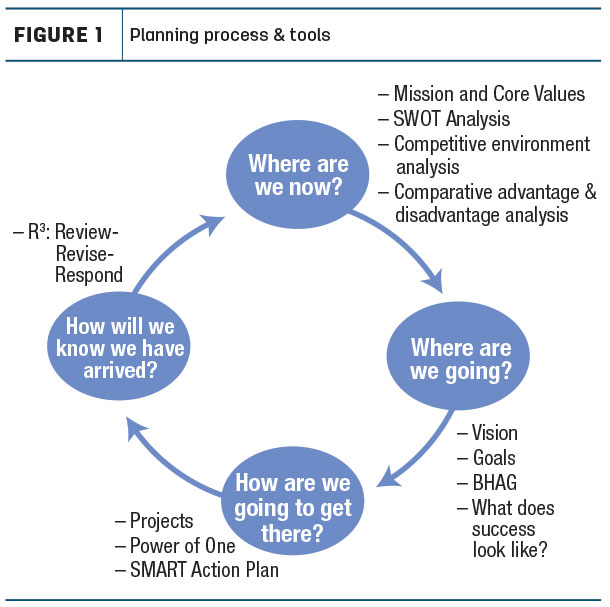As we approach Christmas and the new year, I must admit to being almost giddy with the idea of saying goodbye to 2020.
There is always a comic at the new year showing an old and wizened Uncle Sam trudging to retirement as the new baby Uncle Sam is full of smiles and wonderment.
The old Uncle Sam of 2020 saw a year of disruption, upheaval, volatility – and lots of new government acronyms. Class III prices started the year at $17.05 per hundredweight (cwt) in January, collapsed to $12.14, rebounded to $24.54, and current futures suggest an ending price in the mid-$18 range. Wow. Beyond that roller coaster were negative producer price differentials (PPDs), milk dumping, scrambling to find new markets, protecting our employees from getting sick, several new government programs and, oh yeah, a presidential election.
My mother always coached us kids that in the darkest of storms, look for the sliver of light.
Let’s take Mom’s advice, always a good idea, and not focus too much on the old and wizened Uncle Sam of 2020, but instead adopt the excitement, wonder and enthusiasm of the new babe, 2021. After all, the new babe brings good tidings, our customers becoming reconnected with home cooking, a refocus on the supply chain and consumers developing a greater taste for dairy products, to name a few.
Resolutions: Be an 8-percenter
A new year always elicits new resolutions, goals and plans for how to better our business, family and self. However, a quick Google search shows that only 8% of Americans keep their resolutions throughout the year, and 80% have failed by February. How can we become an 8-percenter in 2021?
Do any of these ideas sound familiar?
- Improving cow comfort
- Creating better standards for calf care
- Evaluating herd genetics
- Incorporating a financial record-keeping system
- Developing a transition plan
- Instituting a marketing plan
- Designing plans for expansion or a new enterprise
The 8-percenters not only had the same ideas, but they took the next big step, planning and implementing those ideas. Dwight Eisenhower, as supreme commander of the Allied Forces in World War II, remarked that, “In preparing for battle, I have always found that plans are useless, but planning is indispensable.” Planning is the critical first step toward achieving successful outcomes, but planning which building the bulldozer should knock down does not achieve the outcome; rather, someone has to start up the dozer and implement the plan.
A recipe built on principles
So how can you be an 8-percenter this next year? First, there are two principles I’ll suggest:
- Keep it simple
- Power of One
Figure 1 shows a simple recipe and some management tools based on the steps of:
- Where are we now?
- Where are we going?
- How do we get there?
- How do we know when we have arrived?

“Where are we now?” is an honest examination of the internal status of our operation and external environment in which we conduct business. What is the financial position (balance sheet), financial performance (income statement), production records, health records, employee status, management skills and deficiencies? It is also an external view of markets, labor, regulatory and other external forces both good and challenging.
One of the best tools to address this question is an internal Strengths and Weaknesses and external Opportunities and Threats (SWOT) analysis. SWOT analysis has been around forever, but every time I think a new cool tool will replace it, I find myself reaching back for SWOT.
Once you know where you are, you can use that to inform “Where are you going?” This is the fun and creative part of the planning process. What is your long-term vision for this farm business? What is your BHAG, an acronym that stands for “Big, Hairy, Audacious Goal?” Your vision and BHAG are the pot of gold at the end of the rainbow. It helps to set your sites on the horizon and align your resources to all head in that direction. However, at some point, one needs to force themselves back to the reality of what slice of that vision or BHAG makes sense and is doable this next year? What is this year’s milepost marker?
The next step, “How are we going to get there?” is the all-important step of implementation. What are the projects or initiatives that will be taken up and accomplished this year? What are the milestones of success and, most important, what is the SMART action plan? SMART is another acronym that stands for specific, measurable, accountability, relevant and timeframe. It always amazes me how quickly the most grandiose of plans can get “real” when one is forced to write a SMART action plan.
The “A” usually stands for attainable or achievable. I’ll lump that in with relevant and use the “A” for accountability. If someone is not assigned and held accountable, then I can almost guarantee it will not get done. And put a timeframe with that accountability. After all, there is nothing like facing the guillotine at the next management meeting to focus the mind.
Simplicity is important and is the cousin of flexibility. Be specific in the outcomes to achieve, but let the implementation of how to get there be more organic and flexible. Think of Eisenhower’s quote, “… plans are useless, but planning is indispensable.” Who knows what will happen to cause one to pivot in implementation? There is no better lesson of that than 2020. Maybe you don’t use a bulldozer to accomplish your specific goal of knocking down the building, maybe just a match instead – either way, the SMART goal was accomplished.
The Power of One
My final recommendation to you, and the most important of all, is the “Power of One.” Over my career, I have been a part of dozens of planning processes, sometimes as a participant, sometimes as the leader. In those experiences, I have found very few to be completely successful. Don’t get me wrong, going through the exercise itself may help motivate and inform management decisions. But in terms of being a true 8-percenter, way too many plans were very well crafted, had dynamic ideas and presented the path toward the greatest of successes. However, at the end of the year, there sat the three-ring binder with its detailed plans, colored diagrams and flow charts.
What happened? Life happened. The cows had to be fed, watered, bred and milked; the corn had to be planted and harvested; and taxes had to be done. The power of one is picking out that one high priority and putting the focus on accomplishing that one step forward.
As an example, as past leader of the agribusiness program where I teach, we started each year with a fun and invigorating exercise of how to make the program better, more responsive to students and more recognized for excellence by employers. We had a super list of great ideas, but then “life” happened. We had to teach, grade papers, sit on committees, complete research, write grants, etc. At the end of the year, accomplishment was, well, not so much.
One year, we decided to only focus on one thing. It was hard to throw out so many good ideas, but we made ourselves agree on one goal for the entire year beyond our normal duties: the development and implementation of a short-term study-abroad program for students. We developed a simple SMART action plan that could almost fit on a postcard. We assigned accountability and held each other to it at each meeting throughout the year. In the end, it was accomplished – and since that time we have taken agriculture students, many who had barely ever left the state of Wisconsin, on one- to two-week trips abroad to England, Spain, Thailand, India and Ghana, to name a few.
As you contemplate your business in 2021, what is your BHAG and your power of one?






